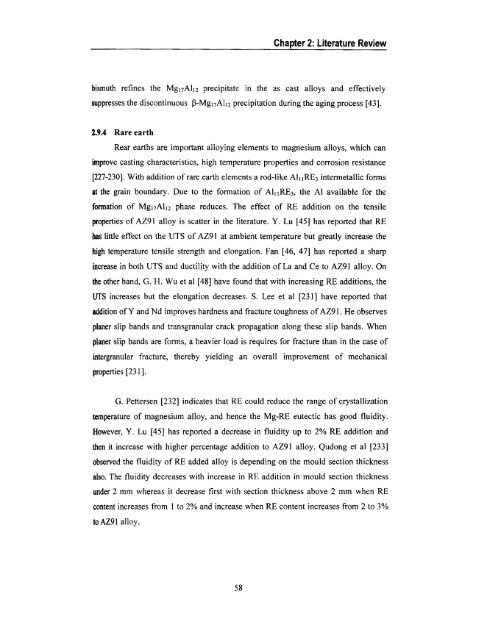“Influence of Si, Sb and Sr Additions on the Microstructure ...
“Influence of Si, Sb and Sr Additions on the Microstructure ...
“Influence of Si, Sb and Sr Additions on the Microstructure ...
Create successful ePaper yourself
Turn your PDF publications into a flip-book with our unique Google optimized e-Paper software.
_ H Chapter 2: Literature Review<br />
bismuth refines <strong>the</strong> Mg|7Al12 precipitate in <strong>the</strong> as cast alloys <str<strong>on</strong>g>and</str<strong>on</strong>g> effectively<br />
suppresses <strong>the</strong> disc<strong>on</strong>tinuous [5-Mg17Al12 precipitati<strong>on</strong> during <strong>the</strong> aging process [43].<br />
2.9.4 Rare earth<br />
Rear earths are important alloying elements to magnesium alloys, which can<br />
improve casting characteristics, high temperature properties <str<strong>on</strong>g>and</str<strong>on</strong>g> corrosi<strong>on</strong> resistance<br />
[227-230]. With additi<strong>on</strong> <str<strong>on</strong>g>of</str<strong>on</strong>g> rare earth elements a rod-like All IRE; intermetallic forms<br />
at <strong>the</strong> grain boundary. Due to <strong>the</strong> formati<strong>on</strong> <str<strong>on</strong>g>of</str<strong>on</strong>g> AIHRE3, <strong>the</strong> Al available for <strong>the</strong><br />
formati<strong>on</strong> <str<strong>on</strong>g>of</str<strong>on</strong>g> MgnAl|2 phase reduces. The effect <str<strong>on</strong>g>of</str<strong>on</strong>g> RE additi<strong>on</strong> <strong>on</strong> <strong>the</strong> tensile<br />
properties <str<strong>on</strong>g>of</str<strong>on</strong>g> AZ9l alloy is scatter in <strong>the</strong> literature. Y. Lu [45] has reported that RE<br />
has little effect <strong>on</strong> <strong>the</strong> UTS <str<strong>on</strong>g>of</str<strong>on</strong>g> AZ9l at ambient temperature but greatly increase <strong>the</strong><br />
high temperature tensile strength <str<strong>on</strong>g>and</str<strong>on</strong>g> el<strong>on</strong>gati<strong>on</strong>. Fan [46, 47] has reported a sharp<br />
increase in both UTS <str<strong>on</strong>g>and</str<strong>on</strong>g> ductility with <strong>the</strong> additi<strong>on</strong> <str<strong>on</strong>g>of</str<strong>on</strong>g> La <str<strong>on</strong>g>and</str<strong>on</strong>g> Ce to AZ9l alloy. On<br />
<strong>the</strong> o<strong>the</strong>r h<str<strong>on</strong>g>and</str<strong>on</strong>g>, G. H. Wu et al [48] have found that with increasing RE additi<strong>on</strong>s, <strong>the</strong><br />
UTS increases but <strong>the</strong> el<strong>on</strong>gati<strong>on</strong> decreases. S. Lee et al [231] have reported that<br />
additi<strong>on</strong> <str<strong>on</strong>g>of</str<strong>on</strong>g> Y <str<strong>on</strong>g>and</str<strong>on</strong>g> Nd improves hardness <str<strong>on</strong>g>and</str<strong>on</strong>g> fracture toughness <str<strong>on</strong>g>of</str<strong>on</strong>g> AZ9l. He observes<br />
planer slip b<str<strong>on</strong>g>and</str<strong>on</strong>g>s <str<strong>on</strong>g>and</str<strong>on</strong>g> transgranular crack propagati<strong>on</strong> al<strong>on</strong>g <strong>the</strong>se slip b<str<strong>on</strong>g>and</str<strong>on</strong>g>s. When<br />
planer slip b<str<strong>on</strong>g>and</str<strong>on</strong>g>s are forms, a heavier load is requires for fracture than in <strong>the</strong> case <str<strong>on</strong>g>of</str<strong>on</strong>g><br />
intergranular fracture, <strong>the</strong>reby yielding an overall improvement <str<strong>on</strong>g>of</str<strong>on</strong>g> mechanical<br />
properties [231 ].<br />
G. Pettersen [232] indicates that RE could reduce <strong>the</strong> range <str<strong>on</strong>g>of</str<strong>on</strong>g> crystallizati<strong>on</strong><br />
temperature <str<strong>on</strong>g>of</str<strong>on</strong>g> magnesium alloy, <str<strong>on</strong>g>and</str<strong>on</strong>g> hence <strong>the</strong> Mg-RE eutectic has good fluidity.<br />
However, Y. Lu [45] has reported a decrease in fluidity up to 2% RE additi<strong>on</strong> <str<strong>on</strong>g>and</str<strong>on</strong>g><br />
<strong>the</strong>n it increase with higher percentage additi<strong>on</strong> to AZ9l alloy. Qud<strong>on</strong>g et al [233]<br />
observed <strong>the</strong> fluidity <str<strong>on</strong>g>of</str<strong>on</strong>g> RE added alloy is depending <strong>on</strong> <strong>the</strong> mould secti<strong>on</strong> thickness<br />
also. The fluidity decreases with increase in RE additi<strong>on</strong> in mould secti<strong>on</strong> thickness<br />
under 2 mm whereas it decrease first with secti<strong>on</strong> thickness above 2 mm when RE<br />
c<strong>on</strong>tent increases from l to 2% <str<strong>on</strong>g>and</str<strong>on</strong>g> increase when RE c<strong>on</strong>tent increases from 2 to 3%<br />
to AZ91 alloy.<br />
58
















